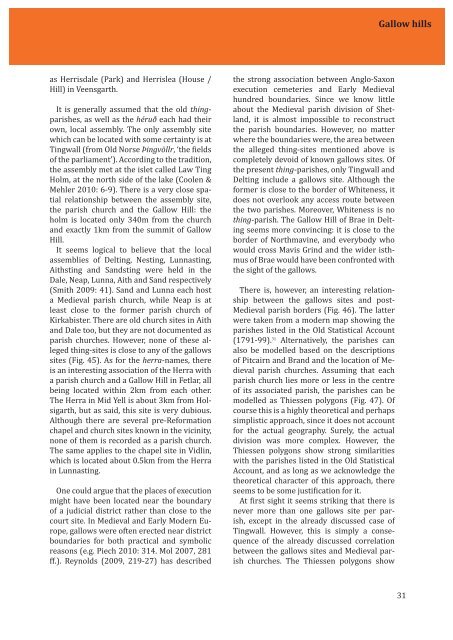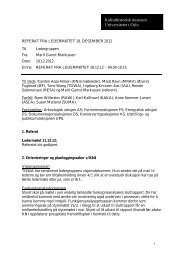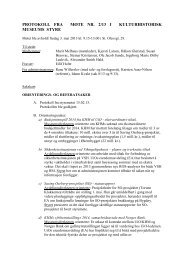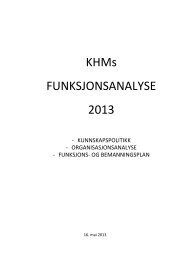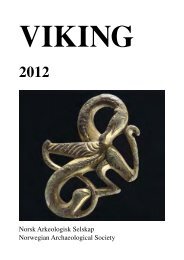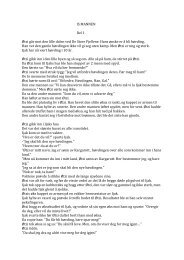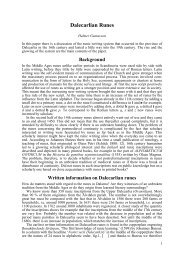TAP Field Report No. 5 A survey of Shetland's gallow hills Joris ...
TAP Field Report No. 5 A survey of Shetland's gallow hills Joris ...
TAP Field Report No. 5 A survey of Shetland's gallow hills Joris ...
- No tags were found...
You also want an ePaper? Increase the reach of your titles
YUMPU automatically turns print PDFs into web optimized ePapers that Google loves.
Gallow <strong>hills</strong>as Herrisdale (Park) and Herrislea (House /Hill) in Veensgarth.It is generally assumed that the old thingparishes,as well as the héruð each had theirown, local assembly. The only assembly sitewhich can be located with some certainty is atTingwall (from Old <strong>No</strong>rse Þingvöllr, ‘the ields<strong>of</strong> the parliament’). According to the tradition,the assembly met at the islet called Law TingHolm, at the north side <strong>of</strong> the lake (Coolen &Mehler 2010: 6-9). There is a very close spatialrelationship between the assembly site,the parish church and the Gallow Hill: theholm is located only 340m from the churchand exactly 1km from the summit <strong>of</strong> GallowHill.It seems logical to believe that the localassemblies <strong>of</strong> Delting, Nesting, Lunnasting,Aithsting and Sandsting were held in theDale, Neap, Lunna, Aith and Sand respectively(Smith 2009: 41). Sand and Lunna each hosta Medieval parish church, while Neap is atleast close to the former parish church <strong>of</strong>Kirkabister. There are old church sites in Aithand Dale too, but they are not documented asparish churches. However, none <strong>of</strong> these allegedthing-sites is close to any <strong>of</strong> the <strong>gallow</strong>ssites (Fig. 45). As for the herra-names, thereis an interesting association <strong>of</strong> the Herra witha parish church and a Gallow Hill in Fetlar, allbeing located within 2km from each other.The Herra in Mid Yell is about 3km from Holsigarth,but as said, this site is very dubious.Although there are several pre-Reformationchapel and church sites known in the vicinity,none <strong>of</strong> them is recorded as a parish church.The same applies to the chapel site in Vidlin,which is located about 0.5km from the Herrain Lunnasting.One could argue that the places <strong>of</strong> executionmight have been located near the boundary<strong>of</strong> a judicial district rather than close to thecourt site. In Medieval and Early Modern Europe,<strong>gallow</strong>s were <strong>of</strong>ten erected near districtboundaries for both practical and symbolicreasons (e.g. Piech 2010: 314. Mol 2007, 281ff.). Reynolds (2009, 219-27) has describedthe strong association between Anglo-Saxonexecution cemeteries and Early Medievalhundred boundaries. Since we know littleabout the Medieval parish division <strong>of</strong> Shetland,it is almost impossible to reconstructthe parish boundaries. However, no matterwhere the boundaries were, the area betweenthe alleged thing-sites mentioned above iscompletely devoid <strong>of</strong> known <strong>gallow</strong>s sites. Ofthe present thing-parishes, only Tingwall andDelting include a <strong>gallow</strong>s site. Although theformer is close to the border <strong>of</strong> Whiteness, itdoes not overlook any access route betweenthe two parishes. Moreover, Whiteness is nothing-parish. The Gallow Hill <strong>of</strong> Brae in Deltingseems more convincing: it is close to theborder <strong>of</strong> <strong>No</strong>rthmavine, and everybody whowould cross Mavis Grind and the wider isthmus<strong>of</strong> Brae would have been confronted withthe sight <strong>of</strong> the <strong>gallow</strong>s.There is, however, an interesting relationshipbetween the <strong>gallow</strong>s sites and post-Medieval parish borders (Fig. 46). The latterwere taken from a modern map showing theparishes listed in the Old Statistical Account(1791-99). 31 Alternatively, the parishes canalso be modelled based on the descriptions<strong>of</strong> Pitcairn and Brand and the location <strong>of</strong> Medievalparish churches. Assuming that eachparish church lies more or less in the centre<strong>of</strong> its associated parish, the parishes can bemodelled as Thiessen polygons (Fig. 47). Ofcourse this is a highly theoretical and perhapssimplistic approach, since it does not accountfor the actual geography. Surely, the actualdivision was more complex. However, theThiessen polygons show strong similaritieswith the parishes listed in the Old StatisticalAccount, and as long as we acknowledge thetheoretical character <strong>of</strong> this approach, thereseems to be some justiication for it.At irst sight it seems striking that there isnever more than one <strong>gallow</strong>s site per parish,except in the already discussed case <strong>of</strong>Tingwall. However, this is simply a consequence<strong>of</strong> the already discussed correlationbetween the <strong>gallow</strong>s sites and Medieval parishchurches. The Thiessen polygons show31


